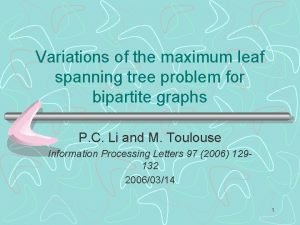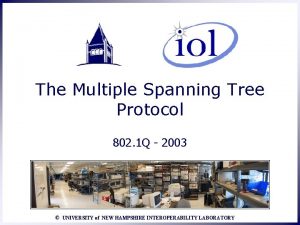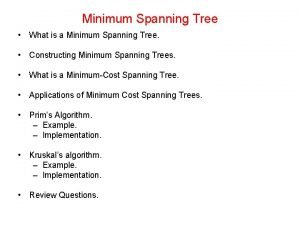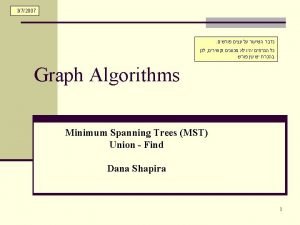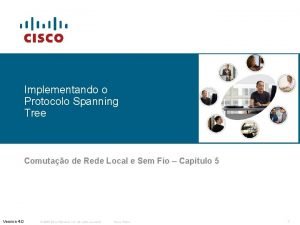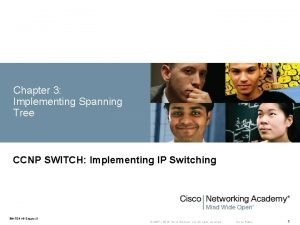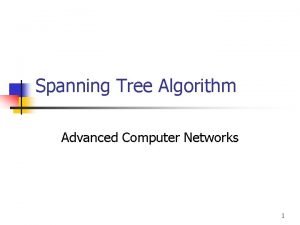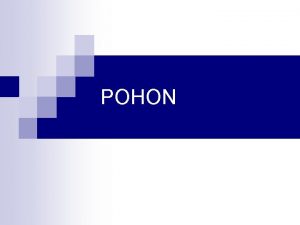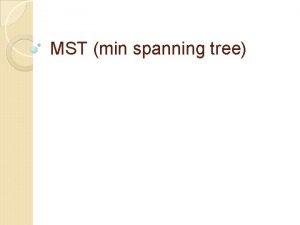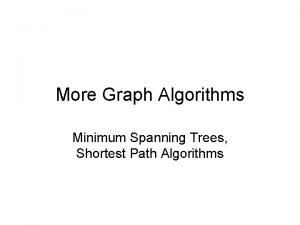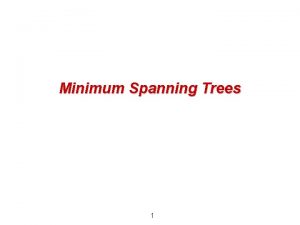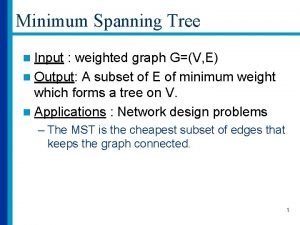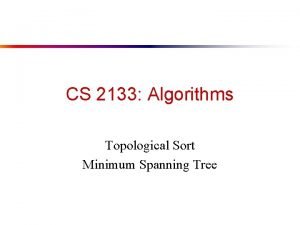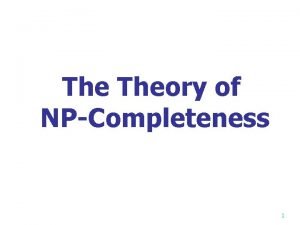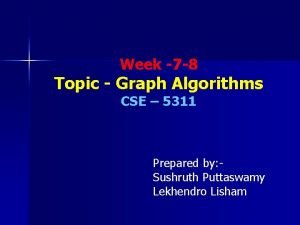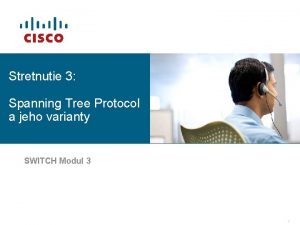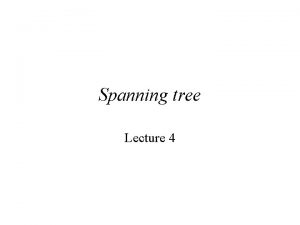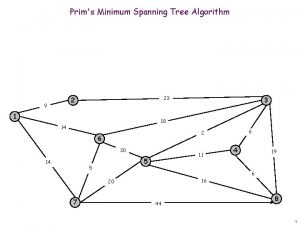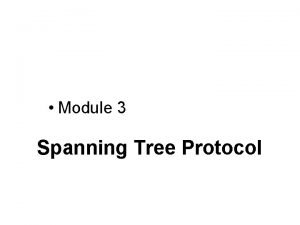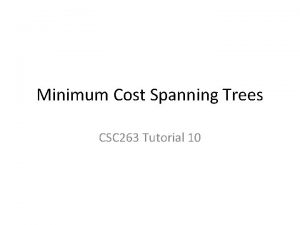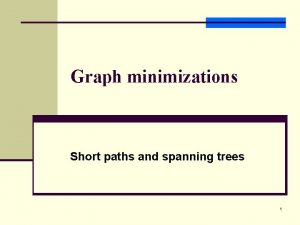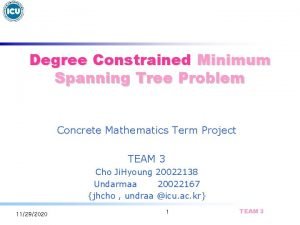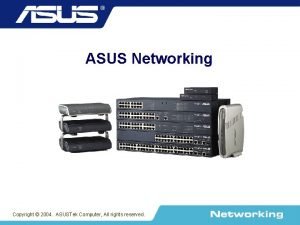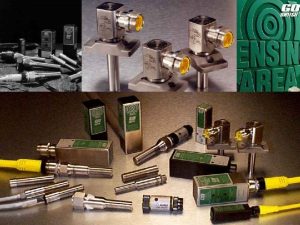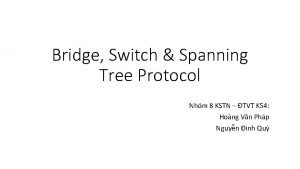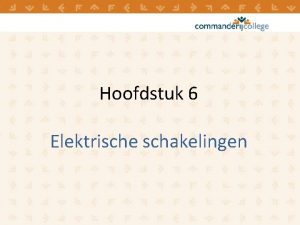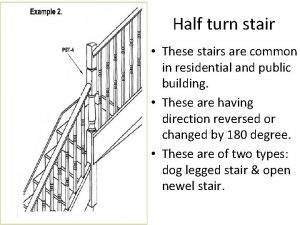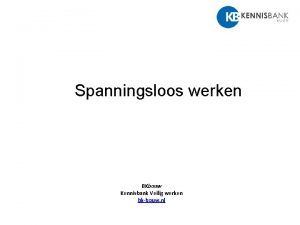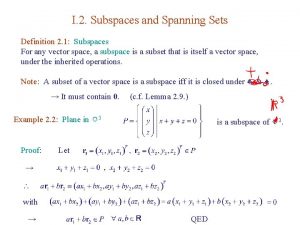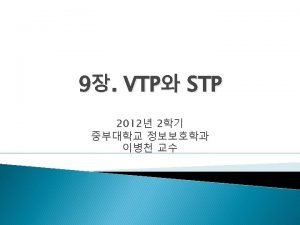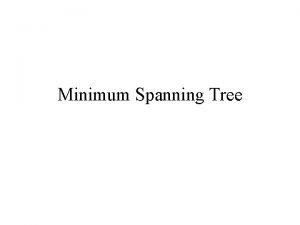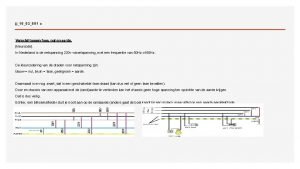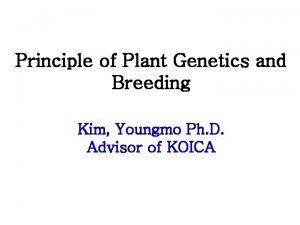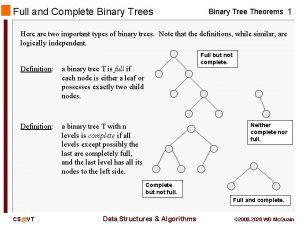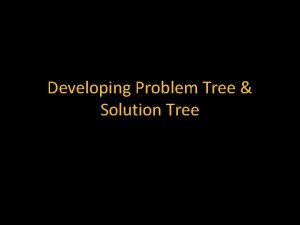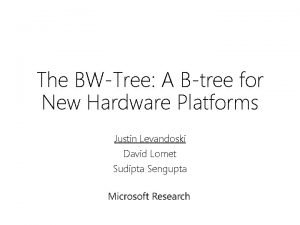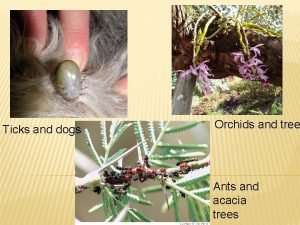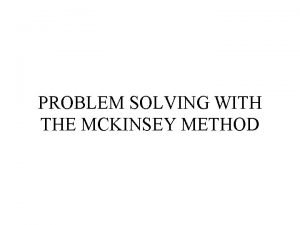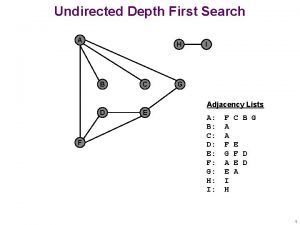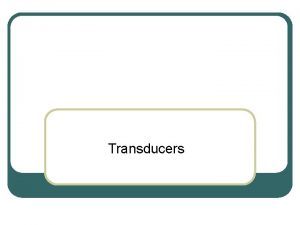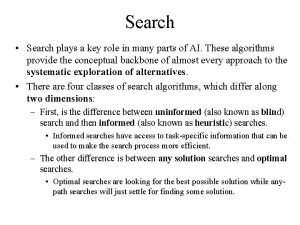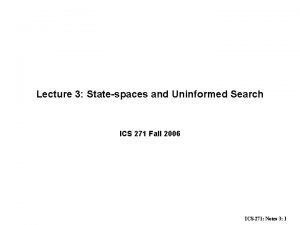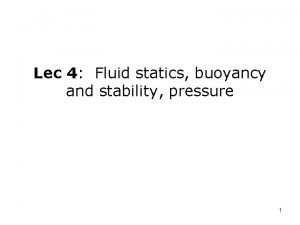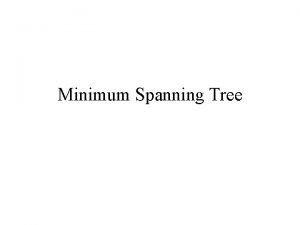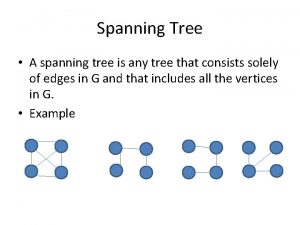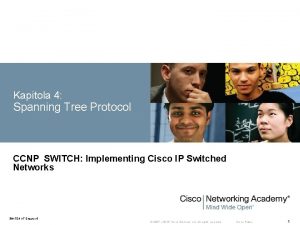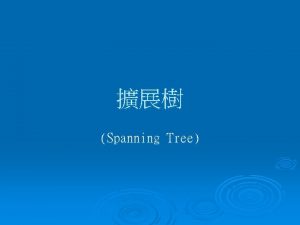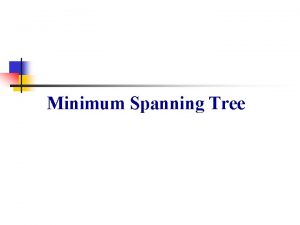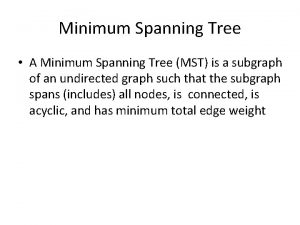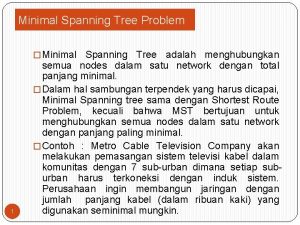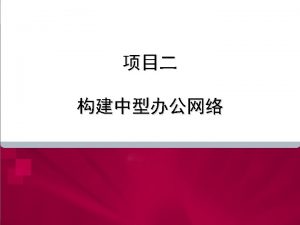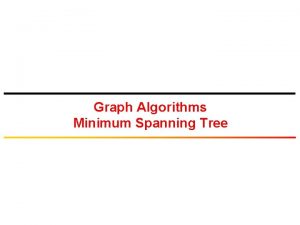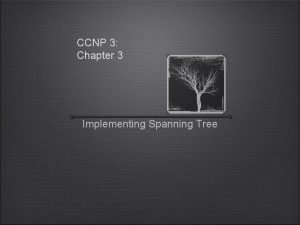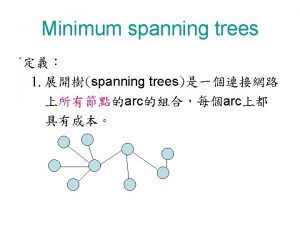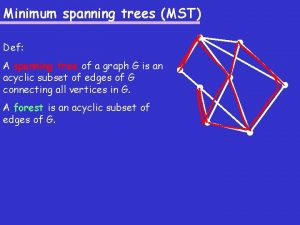Chapter 4 Spanning Tree in Depth CCNP SWITCH





































































































- Slides: 101

Chapter 4: Spanning Tree in Depth CCNP SWITCH: Implementing Cisco IP Switched Networks SWITCH v 7 Chapter 4 © 2007 – 2016, Cisco Systems, Inc. All rights reserved. Cisco Public 1

Chapter 4 Objectives § Spanning Tree Protocol (STP) overview, its operations, and history § Implement Rapid Spanning Tree Protocol (RSTP) § Describe how and where to configure the following features: Port. Fast, Uplink. Fast, Backbone. Fast, BPDU Guard, BPDU Filter, Root Guard, Loop Guard, Unidirectional Link Detection, and Flex. Links § Configure Multiple Spanning Tree (MST) § Troubleshooting STP Chapter 4 © 2007 – 2016, Cisco Systems, Inc. All rights reserved. Cisco Public 2

Spanning Tree Protocol Overview Chapter 4 © 2007 – 2016, Cisco Systems, Inc. All rights reserved. Cisco Public 3

Spanning Tree Protocol Overview Upon completing this section, you will be able to meet these objectives: § Explain the need for STP § List different standards of STP § Describe basic STP operation § Describe bridge protocol data units § Explain the root bridge election § Explain the root port election § Explain designated port election § Explain STP port states § Explain PVST+ § Explain STP topology changes Chapter 4 © 2007 – 2016, Cisco Systems, Inc. All rights reserved. Cisco Public 4

STP Need § Redundant topology can eliminate single points of failure in the network , however, STP blocks certain ports, so there is only one active path to each segment. Chapter 4 © 2007 – 2016, Cisco Systems, Inc. All rights reserved. Cisco Public 5

Redundant Topology Problems § Broadcast storms • Each switch on a redundant network floods broadcast frames endlessly. These frames then travel around the loop in all directions. § Multiple frame transmission • Multiple copies of the same unicast frames may be delivered to destination station, which can cause problems with the receiving protocol. Multiple copies of the same frame can cause unrecoverable errors. § MAC database instability • If a loop occurs, the same source MAC address could be seen on multiple interfaces causing instability. Data forwarding can be impaired when the switch consumes the resources that are coping with instability in the MAC address table. Chapter 4 © 2007 – 2016, Cisco Systems, Inc. All rights reserved. Cisco Public 6

Solution § STP allows physical path redundancy while preventing the undesirable effects of active loops in the network. § STP forces certain ports into a standby state so that they do not listen, forward, or flood data frames. § There is only one active path to each network segment. § If there is a problem with connectivity to any of the segments, STP reestablishes connectivity by automatically activating a previously inactive path. § STP uses bridge protocol data units (BPDUs) for its operations. Chapter 4 © 2007 – 2016, Cisco Systems, Inc. All rights reserved. Cisco Public 7

STP Standards Chapter 4 © 2007 – 2016, Cisco Systems, Inc. All rights reserved. Cisco Public 8

STP Operations STP provides loop resolution by managing the physical path to the given network segment, by performing the following three steps: § 1. Elects one root bridge • Only one bridge can act as the root bridge. The root bridge is the reference point; all data flows in the network are from the perspective of this switch. All ports on a root bridge are forwarding traffic. § 2. Selects the root port on the nonroot bridge • One port on each nonroot bridge I the root port. It is the port with the lowest-cost path from the nonroot bridge to the root bridge. By default, STP path cost is calculated from the bandwidth of the link. You can also set STP path cost manually. § 3. Selects the designated port on each segment • There is one designated port on each segment. It is selected on the bridge with the lowest-cost path to the root bridge. Chapter 4 © 2007 – 2016, Cisco Systems, Inc. All rights reserved. Cisco Public 9

STP Operations Chapter 4 © 2007 – 2016, Cisco Systems, Inc. All rights reserved. Cisco Public 10

STP Port Roles Chapter 4 © 2007 – 2016, Cisco Systems, Inc. All rights reserved. Cisco Public 11

Bridge Protocol Data Units § STP uses BPDUs to exchange STP information, specifically for root bridge election and for loop identification. § By default, BPDUs are sent out every 2 seconds. § BPDUs are generally categorized into two types: • Configuration BDPUs • Used for calculating the STP • TCN (topology change notification) BPDUs • Used to inform changes in the network topology Chapter 4 © 2007 – 2016, Cisco Systems, Inc. All rights reserved. Cisco Public 12

The BPDU Frame § § § Protocol ID: Identifies the STP Version: Identifies the current version of the protocol Message Type: Identifies the type of BPDU (configuration or TCN BPDU) Flags: Used in response to a TCN BPDU Root Bridge ID: Identifies the bridge ID (BID) of the root bridge Root Path Cost: Identifies the cost from the transmitting switch to the root Sender Bridge ID: Identifies the BID of the transmitting switch Port ID: Identifies the transmitting port Message Age: Indicates the age of the current BPDU Max Age: Indicates the timeout value Hello Time: Identifies the time interval between generations of configuration BPDUs by the root § Forward Delay: Defines the time a switch port must wait in the listening and learning state Chapter 4 © 2007 – 2016, Cisco Systems, Inc. All rights reserved. Cisco Public 13

Root Bridge Election § The root bridge is chosen with an election. § In STP, each switch has a unique BID that consists of the following: • Bridge priority (a value between 0 and 65, 535, with the default being 32, 768) • MAC address § The root bridge is selected based on the lowest BID. § If all switches in the network have the same priority, the switch with the lowest MAC address becomes the root bridge Chapter 4 © 2007 – 2016, Cisco Systems, Inc. All rights reserved. Cisco Public 14

Root Port Election § After the root bridge is elected, each nonroot bridge must figure out where it is in relation to the root bridge. § Root port is the port with the best path to the root bridge. § To determine root ports on nonroot bridges, cost value is used. § The path cost is the cumulative cost of all links to the root bridge. § Root port indicates the lowest cost to the root bridge. Chapter 4 © 2007 – 2016, Cisco Systems, Inc. All rights reserved. Cisco Public 15

Designated Port Election § After the root bridge and root ports on nonroot bridges have been elected, to prevent the loops STP has to identify which port on the segment will forward the traffic. § Only one of the links on a segment should forward traffic to and from that segment. § The designated port, the one forwarding the traffic, is also chosen based on the lowest cost to the root bridge. § On the root bridge, all ports are designated. § If there are two paths with equal cost to the root bridge, STP uses the following criteria for best path determination and consequently for determination of designated and nondesignated ports on the segment: • • Lowest root BID Lowest root path cost to root bridge Lowest sender BID Lowest sender port ID Chapter 4 © 2007 – 2016, Cisco Systems, Inc. All rights reserved. Cisco Public 16

STP Process Chapter 4 © 2007 – 2016, Cisco Systems, Inc. All rights reserved. Cisco Public 17

STP Port States Chapter 4 © 2007 – 2016, Cisco Systems, Inc. All rights reserved. Cisco Public 18

Per-VLAN STP Plus (PVST+) § Per-VLAN STP Plus (PVST+) is a Cisco implementation of STP that provides a separate spanning-tree instance for each configured VLAN in the network. Chapter 4 © 2007 – 2016, Cisco Systems, Inc. All rights reserved. Cisco Public 19

Per-VLAN STP Plus (PVST+) § Spanning-tree operation requires that each switch has a unique BID. § To carry BID information, the extended system ID is accommodated. § The original 16 -bit bridge priority field is split into two fields, resulting in the following components in the BID: § Bridge priority • A 4 -bit field used to carry bridge priority. The default priority is 32, 768, which is the midrange value. The priority is conveyed in discrete values in increments of 4096. § Extended system ID • A 12 -bit field carrying the VLAN ID. § MAC address • A 6 -byte field with the MAC address of the switch. Chapter 4 © 2007 – 2016, Cisco Systems, Inc. All rights reserved. Cisco Public 20

STP Topology Changes Chapter 4 © 2007 – 2016, Cisco Systems, Inc. All rights reserved. Cisco Public 21

Rapid Spanning Tree Protocol Chapter 4 © 2007 – 2016, Cisco Systems, Inc. All rights reserved. Cisco Public 22

Rapid Spanning Tree Protocol Upon completing this section, you will be able to meet these objectives: § List and explain RSTP port roles § Compare RSTP and STP port states § Explain how STP handles topology changes § Describe RSTP link types § Configure and modify STP behavior § Explain how RSTP handles topology changes Chapter 4 © 2007 – 2016, Cisco Systems, Inc. All rights reserved. Cisco Public 23

RSTP Port Roles RSTP defines the following port roles : § Root • The root port is the switch port on every nonroot bridge that is the chosen path to the root bridge. • There can be only one root port on every switch. • The root port is considered as part of active topology. • It forwards, sends, and receives BPDUs (data messages). § Designated • Each switch has at least one switch port as the designated port for the segment. • In active topology, the switch with the designated port receives frames on the segment that are destined for the root bridge. • There can be only one designated port per segment. Chapter 4 © 2007 – 2016, Cisco Systems, Inc. All rights reserved. Cisco Public 24

RSTP Port Roles RSTP defines the following port roles : § Alternate • The alternate port is a switch port that offers an alternate path toward the root bridge. • It assumes a discarding state in an active topology. • The alternate port makes a transition to a designated port if the current designated path fails. § Disabled • A disabled port has no role within the operation of spanning tree. § Backup • The backup port is an additional switch port on the designated switch with a redundant link to the shared segment for which the switch is designated. • The backup port has the discarding state in active topology. Chapter 4 © 2007 – 2016, Cisco Systems, Inc. All rights reserved. Cisco Public 25

RSTP Port Roles Chapter 4 © 2007 – 2016, Cisco Systems, Inc. All rights reserved. Cisco Public 26

Comparison of RSTP and STP Port States Chapter 4 © 2007 – 2016, Cisco Systems, Inc. All rights reserved. Cisco Public 27

RSTP Ports States Chapter 4 © 2007 – 2016, Cisco Systems, Inc. All rights reserved. Cisco Public 28

RSTP Topology Changes § With RSTP, the TC propagation is now a one-step process. In fact, the initiator of the topology change floods this information throughout the network, as opposed to 802. 1 D, where only the root did. § This mechanism is much faster than the 802. 1 D equivalent. § In just a few seconds, or a small multiple of hello times, most of the entries in the CAM tables of the entire network (VLAN) flush. § Why does RSTP not consider link failure a topology change? • Loss of connectivity does not provide new paths in topology. If a switch loses the link to a downstream switch, the downstream switch either has an alternate path to the root bridge or it does not. • If the downstream switch has no alternate path, no action will be taken to improve convergence. • If the downstream switch has an alternate path, the downstream switch will unblock it and consequently generate its own BPDUs with the TC bit set. • Like with STP, Port. Fast-enabled ports do not create topology changes. Chapter 4 © 2007 – 2016, Cisco Systems, Inc. All rights reserved. Cisco Public 29

Configuring and Modifying STP Behavior Chapter 4 © 2007 – 2016, Cisco Systems, Inc. All rights reserved. Cisco Public 30

Changing STP Priority § It is not advised for the network to choose the root bridge by itself. If all switches have default STP priorities, the switch with the lowest MAC address will become the root bridge. § The oldest switch will have the lowest MAC address because the lower MAC addresses were factory-assigned first. § To manually set the root bridge, you can change a switch’s priority § Note • It is highly recommended to configure the distribution or core switches to become the root bridge. Chapter 4 © 2007 – 2016, Cisco Systems, Inc. All rights reserved. Cisco Public 31

Changing STP Priority § The priority can be a value between 0 and 65, 535, in increments of 4096. The default value is 32, 768. § The better solution is to use spanning-tree vlan-id root { primary | secondary } command. § This command is actually a macro that lowers the switch’s priority number for it to become the root bridge. § To configure the switch to become the root bridge for a specified VLAN, use the primary keyword. § Use the secondary keyword to configure a secondary root bridge. § The spanning-tree root command calculates the priority by learning the current root priority and lowering the 4096 value to it. Chapter 4 © 2007 – 2016, Cisco Systems, Inc. All rights reserved. Cisco Public 32

STP Path Manipulation Chapter 4 © 2007 – 2016, Cisco Systems, Inc. All rights reserved. Cisco Public 33

STP Path Manipulation § You can modify port cost by using the spanning-tree vlan-list cost-value command. § The cost value can be between 1 and 65, 535. § You can modify the port priority by using the spanning-tree vlan-list port-priority command. The value of port priority can be between 0 and 255; the default is 128. § A lower port priority means a more preferred path to the root bridge. Chapter 4 © 2007 – 2016, Cisco Systems, Inc. All rights reserved. Cisco Public 34

STP Timers STP uses three different timers to ensure proper loop-free convergence. The three key STP timers and their default values are as follows: § Hello time • The time between each BPDU that is sent on a port. Equals 2 seconds, by default. § Forward delay • The time that is spent in the listening and learning state. Equals 15 seconds, by default. § Max (maximum) age • Controls the maximum length of time that passes before a bridge port saves its configuration BPDU information. Equals 20 seconds, by default. Chapter 4 © 2007 – 2016, Cisco Systems, Inc. All rights reserved. Cisco Public 35

STP Timers § The transition between port states takes from 30 to 50 seconds, depending on the topology change. § This can be adjusted with STP timers. STP hello time can be tuned between 1 and 10 seconds, forward delay between 4 and 30 seconds, and maximum age between 6 and 40 seconds. § To manually configure timers, use the spanning-tree [ vlan-id ] { hello-time | forward-time | max-age } seconds command. Chapter 4 © 2007 – 2016, Cisco Systems, Inc. All rights reserved. Cisco Public 36

Changing the STP Mode to RSTP § The convergence time for RSTP is much shorter than for STP. The entire convergence happens at the speed of BPDU transmission. § That can be less than 1 second. Chapter 4 © 2007 – 2016, Cisco Systems, Inc. All rights reserved. Cisco Public 37

Implementing STP Stability Mechanisms Chapter 4 © 2007 – 2016, Cisco Systems, Inc. All rights reserved. Cisco Public 38

Cisco Spanning Tree Protocol Toolkit Provides tools to better manage STP. The key features of are as follows: § Uplink. Fast: Enables fast uplink failover on access switch § Backbone. Fast: Enables fast convergence in distribution or core layer when STP change occurs § Port. Fast: Configures access port to transition directly to forwarding state Chapter 4 © 2007 – 2016, Cisco Systems, Inc. All rights reserved. Cisco Public 39

Cisco Spanning Tree Protocol Toolkit The key features of the Cisco STP Toolkit that ensure STP stability are as follows: § BPDU Guard • Disables the Port. Fast-enabled port if a BPDU is received § BPDU Filter • Suppresses BPDUs on ports § Root Guard • Prevents external switches from becoming roots § Loop Guard • Prevents an alternate port from becoming the designated port if no BPDUs are received Chapter 4 © 2007 – 2016, Cisco Systems, Inc. All rights reserved. Cisco Public 40

Use Uplink. Fast § If forwarding uplink fails, it will take 30 to 50 seconds for the other uplink to take over. § Uplink. Fast is a Cisco proprietary solution that greatly reduces convergence time. § The Uplink. Fast feature is based on the definition of an uplink group. On a given switch, the uplink group consists of the root port and all the ports that provide an alternate connection to the root bridge. If the root port fails, which means if the primary uplink fails, a port with the next lowest cost from the uplink group is selected to immediately replace it. § The total time to recover the primary link failure will normally be less than 1 second. Chapter 4 © 2007 – 2016, Cisco Systems, Inc. All rights reserved. Cisco Public 41

Use Uplink. Fast § Uplink. Fast is a Cisco proprietary feature § By default, Uplink. Fast is disabled. § To enable Uplink. Fast, use the following command: § ASW(config)# spanning-tree uplinkfast § With RSTP, the Uplink. Fast mechanism is already integrated into the protocol in a standards-based way. Chapter 4 © 2007 – 2016, Cisco Systems, Inc. All rights reserved. Cisco Public 42

Use Backbone. Fast § When an indirect link failure occurs, Backbone. Fast checks whether an alternative path exists to the root bridge. § Indirect failure is when a link that is not directly connected to a switch fails. Chapter 4 © 2007 – 2016, Cisco Systems, Inc. All rights reserved. Cisco Public 43

Use Backbone. Fast Normally a switch must wait for the maximum age timer to expire before responding to the inferior BPDUs. However Backbone. Fast searches for an alternative path: § If the inferior BPDU arrives on a port that is blocked, the switch assumes that the root port and all other blocked ports are an alternative path. § If the inferior BPDU arrives on a port that is root, the switch assumes all blocked are an alternate path. § If no ports are blocked, the switch assumes that it lost connectivity with the root bridge and considers itself as the root bridge. After the switch identifies potential alternative ports, it starts sending RLQs (request link queries). By sending these queries, it finds out whether upstream switches have a path to the root bridge. Chapter 4 © 2007 – 2016, Cisco Systems, Inc. All rights reserved. Cisco Public 44

Use Backbone. Fast § To configure Backbone. Fast, use the following command: • DSW 1(config)# spanning-tree backbonefast § By default, Backbone. Fast is disabled. § To verify the current Backbone. Fast state, issue the following command: • DSW 1# show spanning-tree backbonefast • Backbone. Fast is enabled § Backbone. Fast was implemented into RSTP implementation differs a bit from Backbone. Fast. Whereas Backbone. Fast relies on RLQ messages to validate the current root bridge, RSTP relies on cached information. Chapter 4 © 2007 – 2016, Cisco Systems, Inc. All rights reserved. Cisco Public 45

Use Port. Fast § When Port. Fast is enabled, the port transitions immediately from blocking to forwarding. § Port. Fast should be enabled on access layer switches where the hosts are connected. § An additional benefit of using Port. Fast is that TCN BPDUs are not sent when a switch port in Port. Fast mode goes up or down. § By default, Port. Fast is disabled on all switch ports. § You can configure Port. Fast in two ways: per port and globally. • If you configure Port. Fast globally, all ports that are configured as access ports automatically become Port. Fast enabled, and the port will immediately transition to forwarding. • If a port does receive a BPDU, that port will go into blocking mode. • If you configure Port. Fast per port • The port will be Port. Fast enabled even if it receives BPDUs Chapter 4 © 2007 – 2016, Cisco Systems, Inc. All rights reserved. Cisco Public 46

Use Port. Fast Chapter 4 © 2007 – 2016, Cisco Systems, Inc. All rights reserved. Cisco Public 47

Port. Fast Configuration for a Trunk § Never use the Port. Fast feature on switch ports that connect to other switches, hubs, or routers. § You can also enable Port. Fast on trunk ports. § This is useful if you have a trunk enabled for a host such as a server that needs multiple VLANs. § To enable a port for Port. Fast on an interface that connects to such a server, use the following interface configuration commands: Chapter 4 © 2007 – 2016, Cisco Systems, Inc. All rights reserved. Cisco Public 48

Securing Port. Fast Interface with BPDU Guard § BPDU Guard protects the integrity of ports that are Port. Fast enabled. § If any BPDU is received on a Port. Fast-enabled port, that port is put into err-disabled state. § That means the port is shut down and must be manually reenabled or automatically recovered through the errordisabled timeout function. § It is highly recommended to always enable BPDU Guard on all Port. Fast-enabled ports. Chapter 4 © 2007 – 2016, Cisco Systems, Inc. All rights reserved. Cisco Public 49

Securing Port. Fast Interface with BPDU Guard § By default, BPDU Guard is disabled on all switch ports. § BPDU Guard can be configured in two ways, globally and per port. § Global configuration is conditional: If the port is not Port. Fast enabled, BPDU Guard will not be activated. Chapter 4 © 2007 – 2016, Cisco Systems, Inc. All rights reserved. Cisco Public 50

Disabling STP with BPDU Filter § BPDUs are sent on all ports, even if they are Port. Fast enabled. § You should always run STP to prevent loops. § However, in special cases, you need to prevent BPDUs from being sent out. § You can achieve that by using BPDU Filter. Chapter 4 © 2007 – 2016, Cisco Systems, Inc. All rights reserved. Cisco Public 51

Disabling STP with BPDU Filter behaves differently if applied globally or on a perport basis. § When enabled globally, BPDU Filter has these attributes: • It affects all operational Port. Fast ports on switches that do not have BPDU Filter configured on the individual ports. • If BPDUs are detected, the port loses its Port. Fast status, BPDU Filter is disabled, and the STP sends and receives BPDUs on the port as it would with any other STP port on the switch. • Upon startup, the port transmits ten BPDUs. If this port receives any BPDUs during that time, Port. Fast and Port. Fast BPDU Filter are disabled. § When enabled on an individual port, BPDU Filter has these attributes: • It ignores all BPDUs received. • It sends no BPDUs. Chapter 4 © 2007 – 2016, Cisco Systems, Inc. All rights reserved. Cisco Public 52

Use Root Guard § The Root Guard feature forces an interface to become a designated port to prevent surrounding switches from becoming a root switch. § In other words, Root Guard provides a way to enforce the root bridge placement in the network. § If the bridge receives superior STP BPDUs on a Root Guard -enabled port, the port moves to a root-inconsistent STP state and the switch does not forward traffic out of that port. Chapter 4 © 2007 – 2016, Cisco Systems, Inc. All rights reserved. Cisco Public 53

Use Root Guard § The current design recommendation is to enable Root Guard on all access ports so that a root bridge is not established through these ports. Chapter 4 © 2007 – 2016, Cisco Systems, Inc. All rights reserved. Cisco Public 54

Configuring and Verifying Root Guard Chapter 4 © 2007 – 2016, Cisco Systems, Inc. All rights reserved. Cisco Public 55

Loop Guard Overview § STP relies on continuous reception or transmission of BPDUs based on the port role. § The designated port transmits BPDUs, and the nondesignated port receives BPDUs. § When one of the ports in a physically redundant topology no longer receives BPDUs, the STP conceives that the topology is loop free. § Eventually, the blocking port from the alternate or backup port becomes designated and moves to a forwarding state. § This situation creates a loop. § The Loop Guard feature makes additional checks. If BPDUs are not received on a nondesignated port, and Loop Guard is enabled, that port is moved into the STP loopinconsistent blocking state, instead of the listening/learning/forwarding state. Chapter 4 © 2007 – 2016, Cisco Systems, Inc. All rights reserved. Cisco Public 56

Loop Guard Overview Chapter 4 © 2007 – 2016, Cisco Systems, Inc. All rights reserved. Cisco Public 57

Loop Guard Overview § When the Loop Guard blocks an inconsistent port, this message is logged: § Once the BPDU is received on a port in a loop-inconsistent STP state, the port transitions into another STP state. After recovery, this message is logged: Chapter 4 © 2007 – 2016, Cisco Systems, Inc. All rights reserved. Cisco Public 58

Loop Guard Placement § The Loop Guard feature is enabled on a per-port basis. § However, as long as it blocks the port on the STP level, Loop Guard blocks inconsistent ports on a per-VLAN basis § By default, Loop Guard is disabled. You can configure Loop Guard globally or on a port-per-port basis. § If you enable Loop Guard globally, then effectively, it is enabled on all point-to-point links. Chapter 4 © 2007 – 2016, Cisco Systems, Inc. All rights reserved. Cisco Public 59

Loop Guard vs Root Guard § The Root Guard is mutually exclusive with the Loop Guard. § The Root Guard is used on designated ports, and it does not allow the port to become nondesignated. § The Loop Guard works on nondesignated ports and does not allow the port to become designated through the expiration of maximum age. § The Root Guard cannot be enabled on the same port as the Loop Guard. § When the Loop Guard is configured on the port, it disables the Root Guard configured on the same port. Chapter 4 © 2007 – 2016, Cisco Systems, Inc. All rights reserved. Cisco Public 60

Use UDLD § Unidirectional links can cause spanning-tree topology loops. § Unidirectional Link Detection (UDLD) enables devices to detect when a unidirectional link exists and also to shut down the affected interface. § UDLD is useful on a fiber port to prevent network issues resulting in miswiring at the patch panel causing the link to be in up/up status but the BPDUs are lost. Chapter 4 © 2007 – 2016, Cisco Systems, Inc. All rights reserved. Cisco Public 61

UDLD Overview Chapter 4 © 2007 – 2016, Cisco Systems, Inc. All rights reserved. Cisco Public 62

UDLD Overview Chapter 4 © 2007 – 2016, Cisco Systems, Inc. All rights reserved. Cisco Public 63

UDLD Overview § UDLD is a Layer 2 protocol that works with the Layer 1 mechanisms to determine the physical status of a link. § Both UDLD peers discover each other by exchanging special frames that are sent to well-known MAC address 01: 00: 0 C: CC: CC § In an Ether. Channel bundle, UDLD will error-disable only the physical link that has failed. § UDLD messages are sent at regular intervals. This timer can be modified. The default setting varies between platforms. The typical value is 15 seconds. § UDLD is a Cisco proprietary protocol that is also defined in RFC 5171. Chapter 4 © 2007 – 2016, Cisco Systems, Inc. All rights reserved. Cisco Public 64

UDLD Operation After UDLD detects a unidirectional link, it can take two courses of action, depending on configured mode. UDLD has two modes: § Normal mode • When a unidirectional link is detected, the port is allowed to continue its operation. UDLD just marks the port as having an undetermined state. A syslog message is generated. § Aggressive mode • When a unidirectional link is detected, the switch tries to reestablish the link. It sends one message a second, for 8 seconds. If none of these messages is sent back, the port is placed in error-disabled state. Chapter 4 © 2007 – 2016, Cisco Systems, Inc. All rights reserved. Cisco Public 65

UDLD Configuration § As with other commands, like Port. Fast, you can enable UDLD on a per-port basis or globally. § It is supported only at the fiber ports. § Use the udld reset command to reset all the interfaces that were shut down by UDLD. Chapter 4 © 2007 – 2016, Cisco Systems, Inc. All rights reserved. Cisco Public 66

Comparing Loop Guard with UDLD Chapter 4 © 2007 – 2016, Cisco Systems, Inc. All rights reserved. Cisco Public 67

UDLD Recommended Practices § Typically, it is deployed on any fiber-optic interconnection. § Use UDLD aggressive mode for best protection. § Turn on in global configuration to avoid operational errors and misses. Chapter 4 © 2007 – 2016, Cisco Systems, Inc. All rights reserved. Cisco Public 68

Use Flex. Links § Flex. Links are a pair of a Layer 2 interfaces, where one interface is configured to act as a backup to the other. § Flex. Links provide link-level redundancy that is an alternative to STP. § STP is automatically disabled on Flex. Links interfaces. Chapter 4 © 2007 – 2016, Cisco Systems, Inc. All rights reserved. Cisco Public 69

Flex. Links Configuration and Verification Chapter 4 © 2007 – 2016, Cisco Systems, Inc. All rights reserved. Cisco Public 70

Flex. Links Guidelines § You can configure only one Flex. Links backup link for any active link § An interface can belong to only one Flex. Links pair. § Neither of the links can be a port that belongs to an Ether. Channel. However, you can configure two port channels as Flex. Links. § A backup link does not have to be the same type (Fast Ethernet, Gigabit Ethernet, or port channel) as the active link. § STP is disabled on Flex. Links ports Chapter 4 © 2007 – 2016, Cisco Systems, Inc. All rights reserved. Cisco Public 71

STP Stability Mechanisms Recommendations Chapter 4 © 2007 – 2016, Cisco Systems, Inc. All rights reserved. Cisco Public 72

STP Stability Mechanisms Recommendations § Port. Fast: Apply to all end-user ports. To secure Port. Fastenabled ports, always combine Port. Fast with BPDU Guard. § Root Guard: Apply to all ports where root is never expected. § Loop Guard: Apply to all ports that are or can become nondesignated. § UDLD: The UDLD protocol enables devices to monitor the physical configuration of the cables and detect when a unidirectional link exists. . § Depending on the security requirements of an organization, the port security feature can be used to restrict the ingress traffic of a port by limiting the MAC addresses that are allowed to send traffic into the port. Chapter 4 © 2007 – 2016, Cisco Systems, Inc. All rights reserved. Cisco Public 73

Configuring Multiple Spanning Tree Protocol Chapter 4 © 2007 – 2016, Cisco Systems, Inc. All rights reserved. Cisco Public 74

Multiple Spanning Tree Protocol 802. 1 s § The main purpose of MST is to reduce the total number of spanning-tree instances to match the physical topology of the network and thus reduce the CPU cycles of a switch § MST is a concept of mapping one or more VLANs to a single STP instance. § The number of instances of spanning tree is reduced to the number of links that are available. Chapter 4 © 2007 – 2016, Cisco Systems, Inc. All rights reserved. Cisco Public 75

VLAN Load Balancing § Two links and 1000 VLANs § The 1000 VLANs map to two MST instances. Rather than maintaining 1000 spanning trees, each switch needs to maintain only two spanning trees, reducing the need for switch resources. Chapter 4 © 2007 – 2016, Cisco Systems, Inc. All rights reserved. Cisco Public 76

Introducing MST § MST allows for the building of multiple spanning trees over trunks by grouping and associating VLANs to spanning-tree instances. § Each instance may have a topology that is independent of other spanning-tree instances. § This architecture provides multiple forwarding paths for data traffic and enables load balancing. § A failure in one forwarding path does not affect other instances with different forwarding paths; hence, this architecture improves network fault tolerance. § MST converges faster than PVRST+ and is backward compatible with 802. 1 D STP, 802. 1 w (RSTP), and the Cisco PVST+ architecture. Chapter 4 © 2007 – 2016, Cisco Systems, Inc. All rights reserved. Cisco Public 77

MST § Benefits • Load-balancing scheme is still possible because half the VLANs follow one separate instance. • The switch utilization is low because it has to handle only two instances. § Drawbacks • The protocol is more complex than the usual spanning tree and therefore requires additional training of the operation staff. • Interaction with legacy bridges is sometimes challenging. Chapter 4 © 2007 – 2016, Cisco Systems, Inc. All rights reserved. Cisco Public 78

MST Regions § MST differs from the other spanning-tree implementations in combining some but not necessarily all VLANs into logical spanning-tree instances. § This difference raises the problem of determining which VLAN is supposed to be associated with which instance. § VLAN-to-instance association is communicated by tagging the BPDUs so that the receiving device can identify the instances and the VLANs to which they apply. § To provide this logical assignment of VLANs to spanning trees, each switch that is running MST in the network has a single MST configuration consisting of following three • An alphanumeric configuration name (32 bytes) • A configuration revision number (2 bytes) • A 4096 -element table that associates each of the potential 4096 VLANs supported on the chassis with a given instance Chapter 4 © 2007 – 2016, Cisco Systems, Inc. All rights reserved. Cisco Public 79

MST Regions § To be part of a common MST region, a group of switches must share the same configuration attributes. § It is the responsibility of the network administrator to propagate the configuration properly throughout the region. Chapter 4 © 2007 – 2016, Cisco Systems, Inc. All rights reserved. Cisco Public 80

MST Regions § The exact VLAN-to-instance mapping is not propagated in the BPDU because the switches need to know only whether they are in the same region as a neighbor. § Therefore, only a digest of the VLAN-to-instance mapping table is sent, along with the revision number and the name. § After a switch receives a BPDU, it extracts the digest and compares it with its own computed digest. § If the digests differ, the mapping must be different, so the port on which the BPDU was received is at the boundary of a region. Chapter 4 © 2007 – 2016, Cisco Systems, Inc. All rights reserved. Cisco Public 81

MST Configuration Revision § The configuration revision number gives you a method of tracking changes that are made to the MST region. § It does not automatically increase each time that you make changes to the MST configuration. § Each time that you make a change, you should increase the revision number by one. Chapter 4 © 2007 – 2016, Cisco Systems, Inc. All rights reserved. Cisco Public 82

STP Instances with MST § MST supports a number of instances. § Instance 0 is the internal spanning tree (IST). Chapter 4 © 2007 – 2016, Cisco Systems, Inc. All rights reserved. Cisco Public 83

STP Instances with MST § All six VLAN instances initially belong to MSTI 0. This is the default behavior. § Then make the half of VLAN instances (11, 22, and 33) mapped to MSTI 1, and the other half (44, 55, and 66) mapped to MSTI 2. § If different root bridges are configured for MSTI 1 and MSTI 2, their topologies will converge differently. § By having different Layer 2 topologies between MST instances, links are more evenly utilized. Chapter 4 © 2007 – 2016, Cisco Systems, Inc. All rights reserved. Cisco Public 84

STP Instances with MST § Within a topology where multiple variations of STP are used, Common Spanning Tree (CST) topology considers an MST region as a single black box. § CST maintains a loopfree topology with the links that connect the regions to each other and to switches that are not running MST Chapter 4 © 2007 – 2016, Cisco Systems, Inc. All rights reserved. Cisco Public 85

Extended System ID for MST § As with PVST, the 12 -bit Extended System ID field is used in MST. § In MST, this field carries the MST instance number. Chapter 4 © 2007 – 2016, Cisco Systems, Inc. All rights reserved. Cisco Public 86

Configuring and Verifying MST Chapter 4 © 2007 – 2016, Cisco Systems, Inc. All rights reserved. Cisco Public 87

Configuring MST with the CCNP Region Chapter 4 © 2007 – 2016, Cisco Systems, Inc. All rights reserved. Cisco Public 88

MST Instance 1 and 2 Configuration § § MST is configured with three instances. VLANs 2 and 3 belong to instance 1. VLANs 4 and 5 belong to instance 2. All other VLANs between 1 and 4094, that are not in instances 1 or 2, belong to instance 0. Chapter 4 © 2007 – 2016, Cisco Systems, Inc. All rights reserved. Cisco Public 89

SPT Root Bridge Configuration Chapter 4 © 2007 – 2016, Cisco Systems, Inc. All rights reserved. Cisco Public 90

Verifying MST Chapter 4 © 2007 – 2016, Cisco Systems, Inc. All rights reserved. Cisco Public 91

Verifying MST Digest Chapter 4 © 2007 – 2016, Cisco Systems, Inc. All rights reserved. Cisco Public 92

Verifying MST Instances Mappings Chapter 4 © 2007 – 2016, Cisco Systems, Inc. All rights reserved. Cisco Public 93

Configuring MST Path Cost § Path cost functions the same as with other STPs, except with MST port costs are configured per instance. Chapter 4 © 2007 – 2016, Cisco Systems, Inc. All rights reserved. Cisco Public 94

Configuring MST Port Priority § Port priority functions the same as with other STPs, except with MST port priorities are configured per instance. Chapter 4 © 2007 – 2016, Cisco Systems, Inc. All rights reserved. Cisco Public 95

MST Protocol Migration § Ensure that all switch-to-switch links on which a rapid transition is desired are full duplex. § Edge ports are defined through the Port. Fast feature. § Carefully decide how many instances are needed in the switched network, and keep in mind that an instance translates to a logical topology. § Decide what VLANs to map onto those instances, and carefully select a root and a backup root for each instance. § Choose a configuration name and a revision number that will be common to all switches in the network. • Cisco recommends that you place as many switches as possible into a single region; it is not advantageous to segment a network into separate regions. Chapter 4 © 2007 – 2016, Cisco Systems, Inc. All rights reserved. Cisco Public 96

MST Protocol Migration § Avoid mapping any VLANs onto instance 0. § Migrate the core first. Change the STP type to MST, and work your way down to the access switches. § The configuration of the features such as the Port. Fast, BPDU Guard, BPDUF Filter, Root Guard, and Loop Guard are also applicable in MST mode. § If you have already enabled these features in the PVST+ mode, it remains active after the migration to MST mode. Chapter 4 © 2007 – 2016, Cisco Systems, Inc. All rights reserved. Cisco Public 97

Chapter 4 Summary § Spanning Tree Protocol (STP) overview, its operations, and history § Implement Rapid Spanning Tree Protocol (RSTP) § Describe how and where to configure the following features: Port. Fast, Uplink. Fast, Backbone. Fast, BPDU Guard, BPDU Filter, Root Guard, Loop Guard, Unidirectional Link Detection, and Flex. Links § Configure Multiple Spanning Tree (MST) § Troubleshooting STP Chapter 4 © 2007 – 2016, Cisco Systems, Inc. All rights reserved. Cisco Public 98

Chapter 4 Labs § CCNPv 7. 1 SWITCH Lab 4. 1 STP § CCNPv 7. 1 SWITCH Lab 4. 2 MST Chapter 4 © 2007 – 2016, Cisco Systems, Inc. All rights reserved. Cisco Public 99

Chapter 4 © 2007 – 2016, Cisco Systems, Inc. All rights reserved. Cisco Public 100

Acknowledgment • Some of the images and texts are from Implementing Cisco IP Switched Networks (SWITCH) Foundation Learning Guide: (CCNP SWITCH 300 -115) by Richard Froom and Erum Frahim (1587206641) • Copyright © 2015 – 2016 Cisco Systems, Inc. • Special Thanks to Bruno Silva Chapter 4 © 2007 – 2016, Cisco Systems, Inc. All rights reserved. Cisco Public 101
 Minimum leaf spanning tree
Minimum leaf spanning tree Common spanning tree
Common spanning tree Spanning tree definition
Spanning tree definition Minimum cost spanning tree
Minimum cost spanning tree Spanning tree
Spanning tree Dijkstra
Dijkstra Definisi pohon matematika diskrit
Definisi pohon matematika diskrit Brily
Brily Dijkstra's algorithm proof
Dijkstra's algorithm proof Cisco spanning tree best practices
Cisco spanning tree best practices Spanning tree algorithm in computer networks
Spanning tree algorithm in computer networks Contoh graf hutan
Contoh graf hutan Minimum spanning tree definition
Minimum spanning tree definition Minimum spanning tree shortest path
Minimum spanning tree shortest path Minimum spanning tree
Minimum spanning tree Minimum spanning tree weighted graph
Minimum spanning tree weighted graph Minimum spanning tree
Minimum spanning tree Solin algorithm
Solin algorithm Non-deterministic algorithm
Non-deterministic algorithm Spanning tree of a graph
Spanning tree of a graph Minimum spanning tree
Minimum spanning tree Stp protocol explained
Stp protocol explained Minimum spanning tree
Minimum spanning tree Prims
Prims Stp convergence
Stp convergence Csc longin
Csc longin Bfs spanning tree
Bfs spanning tree Minimum spanning tree
Minimum spanning tree Degree constrained spanning tree
Degree constrained spanning tree Asus spanning tree protocol
Asus spanning tree protocol Prismatic periscope
Prismatic periscope Clos criteria formula
Clos criteria formula Leverless limit switch
Leverless limit switch Kstn chap 7
Kstn chap 7 Vca toolbox
Vca toolbox Serieschakeling spanning
Serieschakeling spanning Half turn stair angle
Half turn stair angle Veilig werken langs de weg toolbox
Veilig werken langs de weg toolbox Minimum spanning set
Minimum spanning set Vtp version 3
Vtp version 3 Boundary spanning leadership definition
Boundary spanning leadership definition Spanning
Spanning Spanning trees
Spanning trees Boundary spanning adalah
Boundary spanning adalah Spanning tussen fase en aarde
Spanning tussen fase en aarde Species tree
Species tree Difference between plus tree and elite tree
Difference between plus tree and elite tree Complete and full binary tree
Complete and full binary tree Problem and solution tree
Problem and solution tree Difference between general tree and binary tree
Difference between general tree and binary tree Winner tree
Winner tree Explain about threaded binary tree
Explain about threaded binary tree Loser tree
Loser tree 2 4 tree to red black tree
2 4 tree to red black tree Kite
Kite Btree simulation
Btree simulation Example of objective tree
Example of objective tree Problem tree and objective tree
Problem tree and objective tree H-tree clock tree synthesis
H-tree clock tree synthesis Pohon sintaks
Pohon sintaks How about the orchid to a tree is a tree benefited
How about the orchid to a tree is a tree benefited Mckinsey problem statement examples
Mckinsey problem statement examples Depth-first search
Depth-first search L
L Product line depth
Product line depth Great lakes depth comparison
Great lakes depth comparison Ocean depth zones
Ocean depth zones Content imperative icons
Content imperative icons Depth and complexity frame
Depth and complexity frame Depth of knowledge levels
Depth of knowledge levels Area of cross section of trapezium
Area of cross section of trapezium Breslow thickness
Breslow thickness State space graph
State space graph Skin depth
Skin depth Suncg
Suncg Depth first search lifo
Depth first search lifo Samsung product mix
Samsung product mix Cause of refraction of light
Cause of refraction of light In-depth comprehension
In-depth comprehension Product line example
Product line example Product line vs product mix
Product line vs product mix Lateral barrier jumps
Lateral barrier jumps Isthmus portion in class 2
Isthmus portion in class 2 Basic life support
Basic life support Kussmaul respirations
Kussmaul respirations Binocular disparity
Binocular disparity Level of processing
Level of processing Earth temperature by depth
Earth temperature by depth Spot drill depth calculator
Spot drill depth calculator Overview definition
Overview definition Depth first search algorithm complexity
Depth first search algorithm complexity Does buoyancy increase with depth
Does buoyancy increase with depth Types of perception
Types of perception In depth interview in qualitative research
In depth interview in qualitative research No guilty life no fear in death
No guilty life no fear in death Depth and complexity frame
Depth and complexity frame Relative clarity examples
Relative clarity examples Cues of depth perception
Cues of depth perception Length depth
Length depth Implied depth art
Implied depth art Fluid statics questions
Fluid statics questions Depth of field in sem
Depth of field in sem
